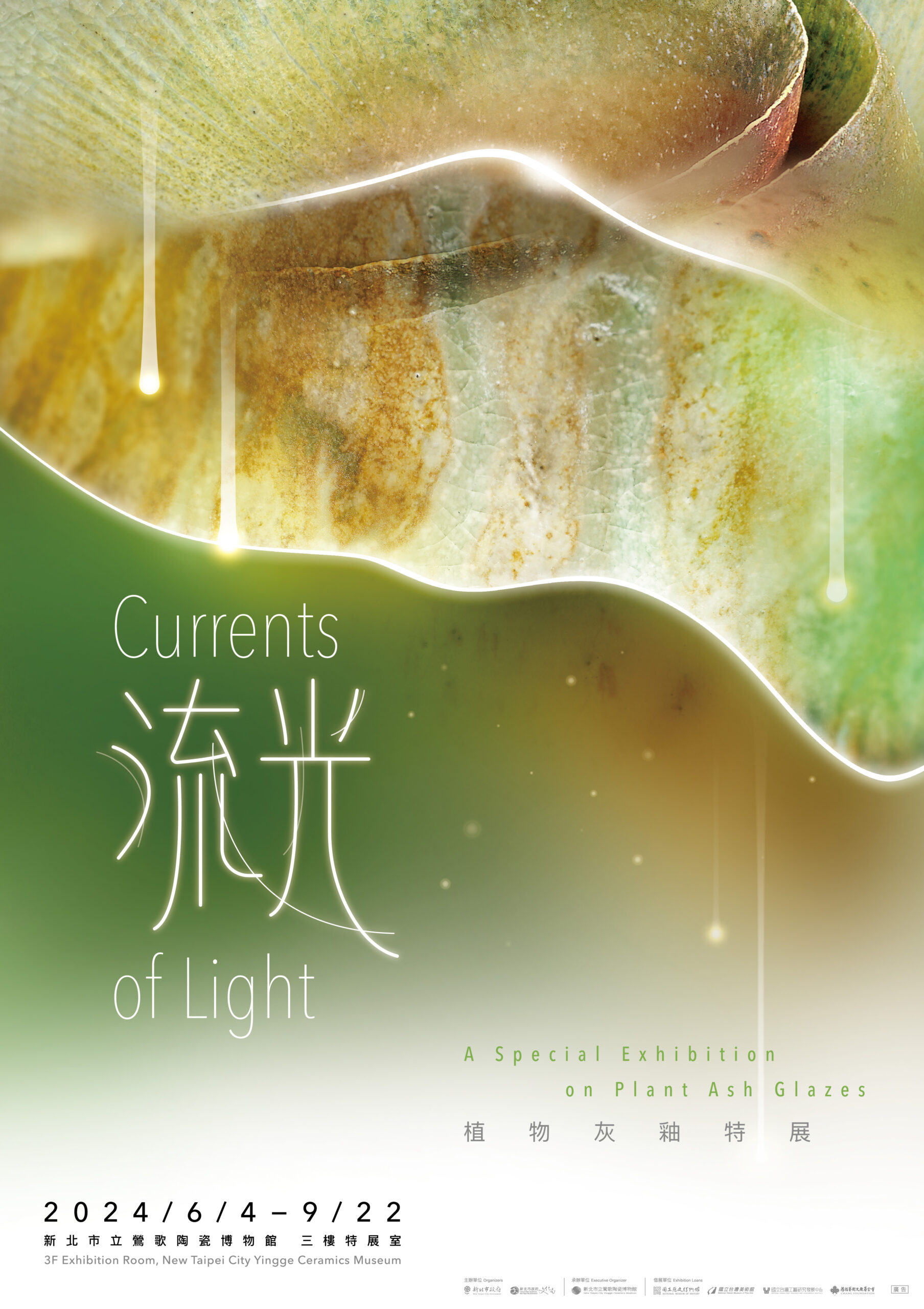- This event has passed.
流光 Currents of Light–灰釉的脈絡與光譜 Tracing the Spectrum and Context of Ash Glaze
15 9 月, 2024 @ 9:30 上午 - 22 9 月, 2024 @ 5:00 下午

在物質性(materiality)成為當代藝術與文化研究專注的主題,而工藝與藝術界線模糊的時刻,具高度技術專業門檻與豐富文化內涵的陶藝,將成為藝術開發者大量投入的領域。對於博物館而言,返身透過陶藝物質材料的特質與文化意義的角度,則能擴大藝術史領域的視野,並開闢新的探索途徑,而再次成為文本或是物件創作者進一步開展材質內涵的資產。
本次展覽以本館出版之《灰釉–植物灰的故事與應用 》一書為基礎,從個別材質的文化流變、科學特性到創作表現形態的梳理,集合跨越時空的窯口樣本、同一流派系統的作品共同展出,提供知識性建構的基礎之外,也是同一主題作品跨時代與類型並陳,體驗鑑賞的機會。
將灰燼轉化為陶瓷表面玻璃質的灰釉,從自然落灰的發現到人工採集、風格開發,期間數千年的發展,貫穿了東亞文明的璀璨歷史。如今它不僅作為材料表現被研究探索,也是精神領域開發的支脈,同時近來也作為社會參與的一項載體。本展期望通過探索灰釉物質性質及與創作過程的關聯,提出對於灰釉的表現形式與意義發掘的新可能。
As materiality becomes a central focus in contemporary art and cultural studies, and the boundaries between craft and art blur, ceramics, with its highly technical expertise and rich cultural heritage, is increasingly gaining attention from art developers. For museums, examining the material characteristics and cultural significance of ceramics offers a new perspective on art history and opens up new avenues of exploration, making ceramics an asset for further expansion in the understanding of materials.
This exhibition, based on the museum’s publication Ash Glaze: The Story and Application of Plant Ash, traces the cultural evolution, scientific properties, and creative expressions of individual materials. It brings together kiln samples across time and space, as well as works from the same stylistic lineage, to offer both a foundation of knowledge and an opportunity to appreciate works of the same theme across eras and types.
Ash glaze, which transforms ash into a glassy surface on ceramics, has a history spanning thousands of years, from its discovery as natural falling ash to its deliberate collection and style development. It has permeated the brilliant history of East Asian civilization. Today, ash glaze is not only studied as a material but is also explored as a spiritual and social medium. This exhibition seeks to uncover new possibilities for the expression and meaning of ash glaze by examining its material properties and its relationship to the creative process.
從發現到探索 From Discovery to Exploration
窯爐,一個轉生宇宙。
陶土坯體在窯爐中隨著火的溫度升高改變物理結構型態,逐漸堅硬、結實,而窯爐中的火焰、氣流與灰燼則撲飛、遊走、墜落或蒸騰而留下各種足跡於陶土表面,其中來自於植物燃料留下灰燼的鹼性物質,在高溫下與陶土中的酸性物質結合,熔融黏著而成為玻璃質則被稱為灰釉。
我們說的「釉」這個字也不過是近1000年來的用法,事實上由人工施釉的灰釉出土文物在中國殷商時代則約有近4000年的歷史。最早陶器內外無意間留下的油亮表面,能不滲水又更耐久而成為主要實用器皿。
隨著不同植物灰材料的發現與探索,除了生活使用的灰釉持續出現在器皿之外,也發展出了技術高度集中的專業窯口與官窯作品,而成為東亞文化的重要代表。
The kiln is a universe of transformation.
Inside the kiln, clay bodies undergo physical changes as the temperature rises, becoming harder and more durable. The flames, air currents, and ash inside the kiln move about, leaving various traces on the surface of the clay. Alkaline substances from the ash of plant fuel combine with acidic substances in the clay at high temperatures, forming a glassy surface known as ash glaze.
The term “glaze” itself has only been used for about 1,000 years. However, artificial ash-glazed artifacts date back nearly 4,000 years to China’s Shang Dynasty. Early pottery with shiny surfaces, both inside and out, became more durable and water-resistant, making them ideal for practical use.
With the discovery and exploration of different types of plant ash, ash glaze evolved not only as a practical material for everyday use but also developed into a highly specialized craft in professional and imperial kilns, becoming a significant symbol of East Asian culture.
臺灣灰釉的系譜 The Lineage of Ash Glaze in Taiwan
臺灣灰釉的運用除了部分延續早期民生用自然落灰的柴燒,另一部分是工業與學校教育現代化之後,所傳習而來的技術與影響。其中林葆家先生因早期在日本受教育接觸到陶藝,轉而進入專業學校與窯廠,獲取科學化的知識系統。回到臺灣之後,又實地進行採集與試驗,提供窯業工廠與個人諮詢,進而成立「陶林」工作室,影響了許多陶瓷從業者與創作者。其中來自中部的蔡榮祐、女婿薛瑞芳、軍職退休後轉職的張繼陶等,而他們幾位也持斷開設釉藥課程,在林葆家灰釉體系的基礎下創造出各自的風格與脈絡,進而影響後續一系列灰釉的表現與態度。此外,即便已有合成釉的穩定與便利,卻仍鍾情於自然落灰之未知領域之廣大而以自身之力堅持挑戰者,如林錦鐘、羅紹綺以地方的材質,不斷地試驗進而建立出一套屬於自己在地的灰釉系統,也都留下不凡的紀錄與表現。
In Taiwan, the use of ash glaze has been shaped by two main influences: the traditional method of natural falling ash from wood-fired kilns and the modernized techniques brought about by industrial and educational systems. Lin Bao-jia, who studied ceramics in Japan, was instrumental in acquiring a scientific understanding of ash glaze. After returning to Taiwan, he collected materials, conducted experiments, and provided advice to local factories and individuals. His “Taolin” studio greatly influenced many ceramic practitioners, including Cai Rong-you, his son-in-law Xue Rui-fang, and Zhang Ji-tao, who took up ceramics after retiring from the military. These individuals continued to develop their own styles and approaches to ash glaze based on Lin’s teachings, influencing subsequent generations of creators.
Despite the convenience of synthetic glazes, there are still those who are deeply passionate about the vast, unknown potential of natural falling ash and continue to challenge themselves with it. Artists like Lin Jin-zhong and Luo Shao-qi, for example, have experimented with local materials to establish their unique ash glaze systems, leaving remarkable contributions to the field.
與灰釉共享風格生活 Living in Style with Ash Glaze
灰釉也可是一種生活風格型態與價值追求的表現,有別於傳統官窯因禁用、隔絕、稀有所引發眾人追捧與好奇的附加價值;亙古以來,灰釉就在人類生活中既扮演實用功能,也提供直感真切的審美互動。本單元邀請現代陶藝先驅的資深陶藝家邱煥堂、施乃月夫婦,以早年共同開發的灰釉彩繪盤與日常生活的音樂、語言學習、彩繪樂趣,分享他們銀髮松年的灰釉生活;另一對中堅輩夥伴邱玉錡與郭雅玟則以共同經營學堂的方式,將深入陶瓷工廠跟著老師傅拉坯習得的手藝與態度以陶農與教學兼顧,同時展現灰釉品味的生活與大眾分享。此外,茶與陶於生活中向來是不可分割的存在,灰釉與茶又在現代生活展現如何的可能?近來傳統民窯的轉型及學校藝術科系與農村合作製作灰釉,都使灰釉成為社會參與的一環,是灰釉在現代生活光譜中可期待的另類展演。
Ash glaze can also be seen as an expression of lifestyle and value, distinct from the rarity and exclusivity often associated with traditional imperial kilns. Throughout history, ash glaze has served both a practical purpose and provided a direct aesthetic experience. In this section, pioneering ceramic artists Qiu Huan-tang and Shi Nai-yue share their silver-haired years of living with ash glaze through the ash-glazed painted plates they developed, and their daily life filled with music, language learning, and the joy of painting. Another couple, Qiu Yu-qi and Guo Ya-wen, who operate a ceramics school, balance their farming and teaching practices, passing on the craftsmanship they learned from veteran potters and sharing the elegance of ash glaze with the public.
Tea and ceramics have always been inseparable, and this exhibition explores how ash glaze and tea intersect in modern life. The transformation of traditional folk kilns and collaborations between art schools and rural communities in producing ash glaze make it a vehicle for social participation, presenting exciting possibilities for the role of ash glaze in the contemporary spectrum of daily life.
票價 Fee:NT$80




